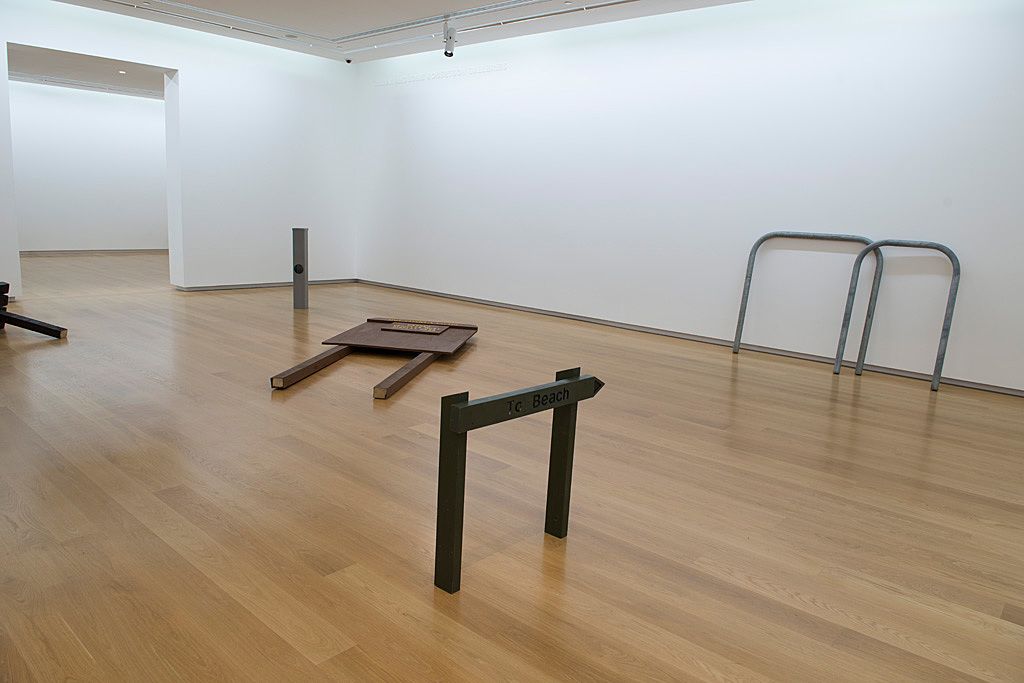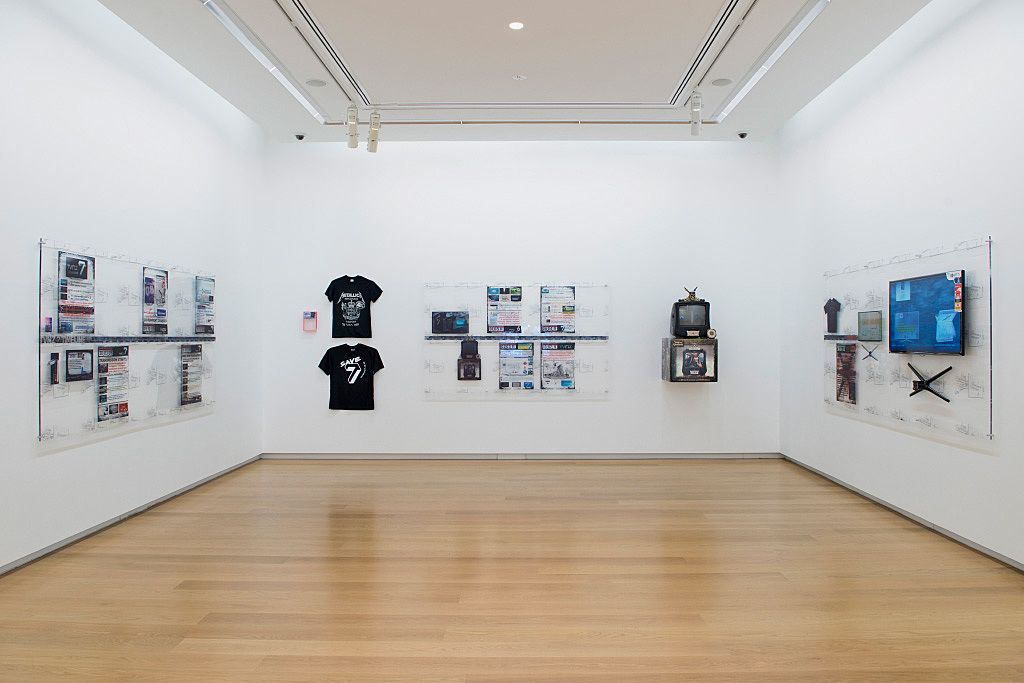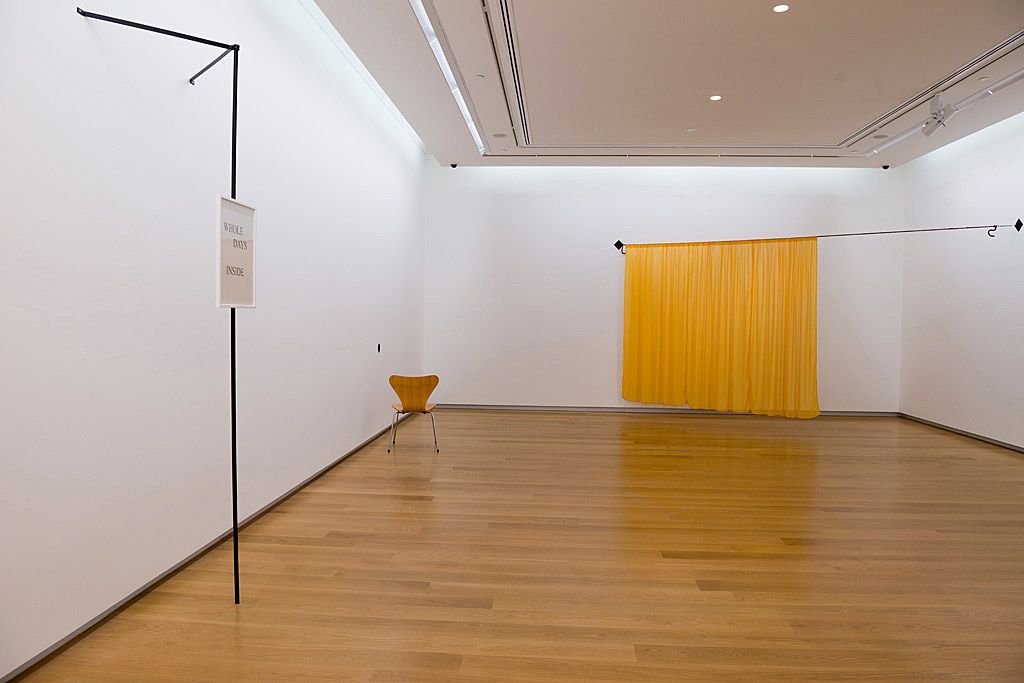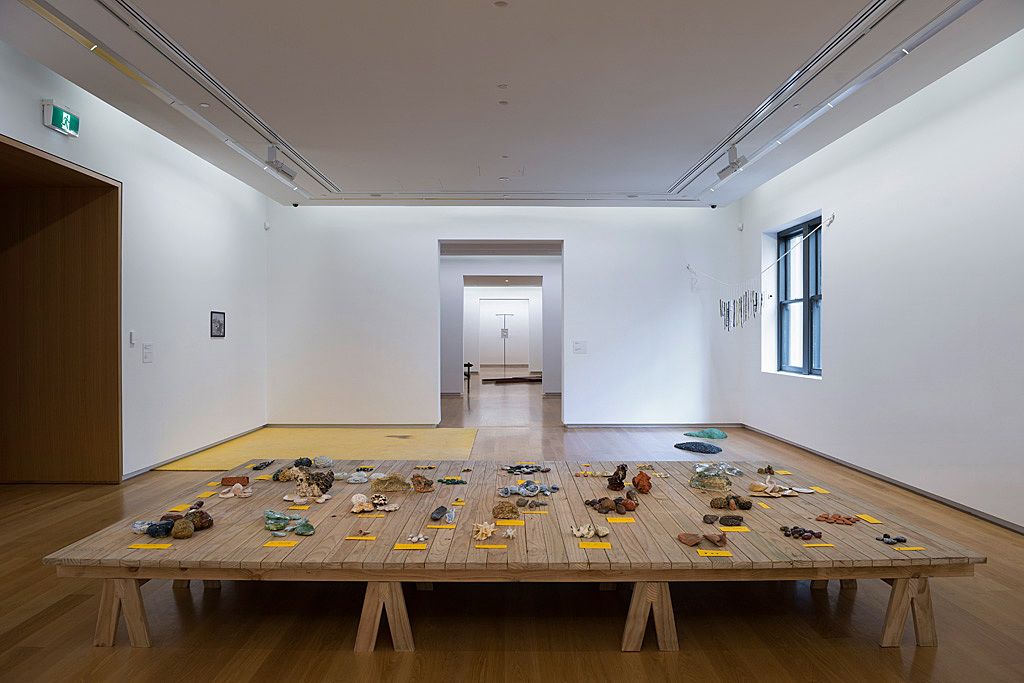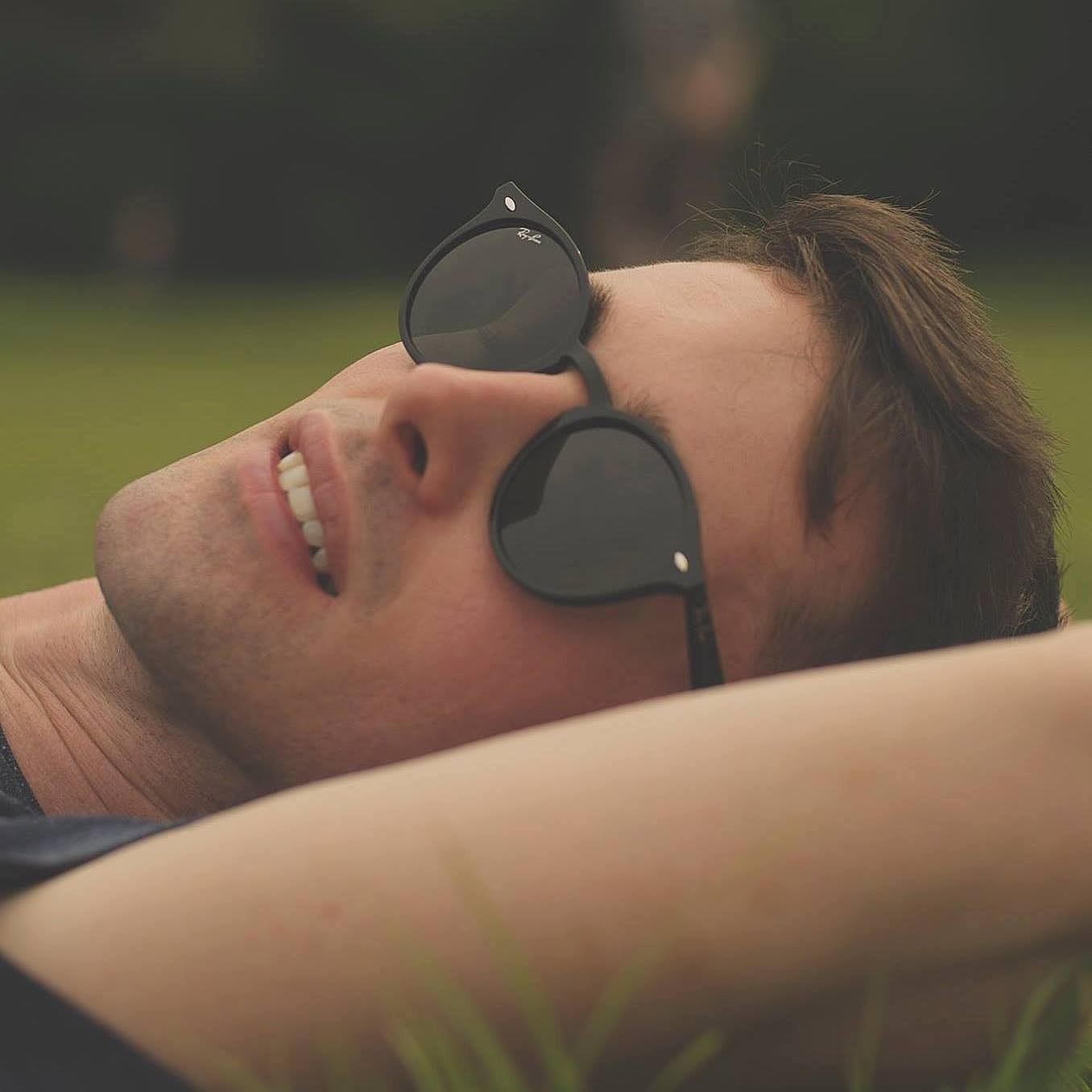Some Smoke, But Not Much Fire: A Review of 'Inside Outside Upside Down'
Despite its superstar line-up, 'Inside Outside Upside Down' is strangely cheerless and unanimated, writes Francis McWhannell
Auckland Art Gallery Toi o Tāmaki is not in the business of placing outside bets. As such, Inside Outside Upside Down: Five Contemporary New Zealand Artists – curated by head of contemporary art Natasha Conland,[1] and comprising materials held by the Gallery – is a showcase not merely of five contemporary NZ artists, but of five of the most celebrated practitioners to have emerged in recent years.[2] It is no coincidence that all are based outside Aotearoa, in places with larger, more prominent art communities and markets. Ruth Buchanan (born 1980, lives in Berlin), Fiona Connor (1981, LA), Simon Denny (1982, Berlin), Kate Newby (1979, NYC), and Ronnie van Hout (1962, Melbourne) – each of whom gets a room of her/his own in IOUD – are at once certified insiders of the NZ art scene (as winners of and finalists in the Walters Prize, holders of important local residencies, etc.) and global players (garnering frieze features and international honours aplenty).
The advantage of exhibiting what we might call the ‘New Canonicals’ is that their work is bound to be of quality. Not for nothing did Denny’s Channel Document (2012) win the Baloise Art Prize at Art 43 Basel. The installation, included in IOUD as Freeview Passport: CD NZ presentation, is consummate in both conception and production,[3] and of broad interest, combining references to recent NZ history – including an exploration of the moulding of national culture/identity by the Clark Government, in the form of a pitch-perfect TVNZ 7-style documentary (part homage, part piss-take) on the development of our current passport – with a more general, but equally cogent, interrogation of market-driven media and media-driven markets (the Pirates of the Caribbean TV really says it all).
To the extent that IOUD presents (or re-presents, since all the works on display have been shown elsewhere before) some important and thought-provoking material, it is successful. I was particularly pleased to have the opportunity to see Buchanan’s absorbing 2012 works, originally exhibited at Hopkinson Cundy (now Hopkinson Mossman) as part of On or within a scenario, which convey diverse and complex ideas or sensations. For instance, the deceptively plain Whole Days Inside – a photographic image of unstylish (Times New Roman?) black text on white, which might have come off any photocopier – is suggestive of a variety of ‘entrapments’, including the corporate world (whole days in the office), domesticity (” ” ” ” house), and introspection (” ” ” ” head).
Examination of the Buchanan suite, however, also reveals a drawback of IOUD – namely, its frequent omission of information that might otherwise provide the visitor with a useful ‘in’. In the case of Buchanan, it would have been worth noting that, when the works were made, the artist was resident at McCahon House, and making regular visits to the E. H. McCormick Research Library at Auckland Art Gallery.[4] Knowing this, one might detect in Whole Days Inside references to McCahon’s use of words in his art, while the notion of ‘inside’ might take on further, more felicitous meanings, such as studio and archive.[5] It would also have been useful to draw an explicit connection between Buchanan and Virginia Woolf, whose 1929 essay/book A Room of One’s Own is quoted in the general introduction to IOUD, but is most clearly relatable to this artist.
Where Newby is concerned, the problem of limited discussion is compounded by a glut of material. The artist would have been better served by a pared back display, concentrating on her more recent works, What a day (2013) and Mr + Mrs Hands (2014), which utilise like materials (clay, glass), and demonstrate like mastery in their making. The former work – centring on a series of ‘wind chimes’, and representing a major mode within Newby’s practice – is mentioned only obliquely on the wall. It warrants more attention. By contrast, the other Newbys on show, including the 2009 works I’m so ready (a stained carpet) and Don’t act all scared like before (Kate)/(Louise) (a pair of photographs) are less accomplished, less interesting, and at something of an aesthetic and conceptual remove.
Probably the least successful element of the exhibition, however, is the vague inside-outside idea around which it is purportedly organised. The introductory text indicates that the ‘installations all show evidence of working the boundaries of interior space – whether that be a mind, a room, or a nation’,[6] and that the artists ‘[perform] a range of simple inversions which bring the outside in or take the inside out’. On the face of it, these statements look fine, but they turn out to be pretty generic. It is difficult to imagine any work of art, installation or otherwise, that could not be understood to explore interiority so loosely defined; it seems inevitable that the process of making and displaying art will involve the transplanting of something (concept, image, object) from one space into another.[7]
In point of fact, there is little to link the artists in IOUD together – besides their preference for installations, and their status as successful ‘expatriates’ – that is not covered by the exhibition’s subtitle. Of course, this doesn’t matter. Although they can be interesting and useful, central theses/themes are not really required for group shows. In the case of IOUD, the ‘conceit’ (Conland’s expression) is both unnecessary and unenlightening. It is further unfortunate in that it supports the presence of some comparatively weak work, in the form of van Hout’s No Exit II (2003). Viewed in relation to the theme, the installation is easily defensible, since it includes things found out of doors, such as (stuffed) magpies and (faux) rocks and logs, as well as footage of the artist in indoor and outdoor environments. It does not, however, stand up well against the other works on display, coming across as anachronistic, overwrought in conception, sloppy in execution, and curiously un-affecting.[8]
Connor’s Mount Gabriel, Ruby and Ash ‘re-mades’ likewise fit perfectly well with the IOUD idea, being signs, benches, barriers, etc. from the (tamed) Great Outdoors of NZ and the USA, replicated in duplicate,[9] and introduced into (equally tamed) interior and exterior exhibition spaces.[10] Though more accomplished than the van Hout, I am not convinced that they represent the strongest examples of her practice. They are, at least, less arresting than other works by the artist,[11] and they risk being overlooked by visitors. Here again, the text provided does not help much. Instead of, say, exploring ways in which such ‘holiday spot’ objects might plug into or undercut the collective psychology of a nation that likes to think it has a special relationship with an unspoiled natural environment, it focuses on their abstraction from their original functions and contexts, as well as their preservation or ‘documentation’ (Connor’s expression) in the gallery. Ultimately, they end up feeling a bit pedestrian.
Indeed, despite its superstar line-up, IOUD as a whole ends up feeling a bit pedestrian. The exhibition title, which comes from a Berenstain Bears book of the same name,[12] suggests whimsy, play. But, Buchanan and Denny notwithstanding, the show itself is strangely cheerless, unanimated, rather like wind chimes that will never see the wind. This is not a consequence of the artists being dull, but of a dullness in the curating. The exhibition wants editing,[13] and it wants deeper and more vibrant discussion, perhaps by way of an audio track (played via an app on visitors’ phones?) that throws up prompts, asks questions, and, most importantly, tells stories. IOUD could have been a remarkable show, one that set the imagination on fire. Instead, it feels like a parade of cautious acquisitions, presented in such a way that neither industry insiders nor public outsiders will be much moved.
Inside Outside Upside Down: Five Contemporary New Zealand Artists
Auckland Art Gallery Toi o Tāmaki
18 July to 1 November 2015
Free admission
[1] As appears to be standard practice at the Gallery, Conland is not credited as curator in the exhibition itself.
[2] Well recent-ish; van Hout emerged somewhat earlier than the others.
[3] Emil Dryburgh recently suggested to me that Denny makes his work with the demands of display and archiving in/by public institutions very much in mind.
[4] The text does note that Buchanan’s ‘process often begins in the space of research’.
[5] The introduction to IOUD notes that the artists on display generally do not enjoy the ‘stability of a traditional studio space’, at least in NZ.
[6] In the case of Newby, ‘installation’ is something of a misnomer, since her room is more a medley than anything else.
[7] Comments such as ‘the spatial sensitivity of installation art invites comparison between “the world” and lived experience’ and ‘the gallery room is an in-between space through which to stage a confluence of intimate and collective experiences’ are similarly nebulous.
[8] Rather ironically, the text on van Hout is probably ‘best in show’.
[9] Connor’s copies are uncannily accurate, with the possible exception of Object No. 12 … (pay station), which includes a digitally printed sticker that feels somewhat inauthentic.
[10] The wall text notes that the works were originally shown in ‘twin settings – a gallery and a suburban paddock’. At the Gallery, the outside set is shown near the Amphitheatre.
[11] See, for example, Connor’s Something Transparent (please go round the back) (2009), originally exhibited at Michael Lett.
[12] I have this information from Conland; it is not given in the exhibition. Here again, the most immediate connection is with Buchanan, whose works share both spatial and pedagogic associations with the book.
[13] Here, I refer to the selection of artists/works, but the wall texts could also do with some proofing. ‘Sartre’ is misspelled ‘Satre’, and ‘today’s artists’ is punctuated incorrectly as ‘todays’ artists’.
